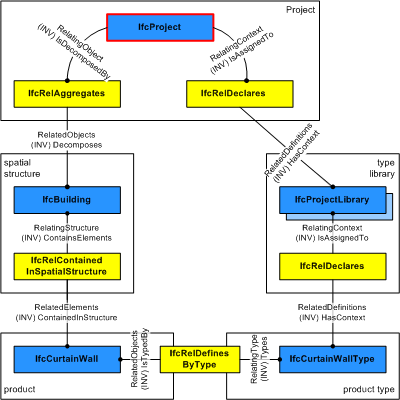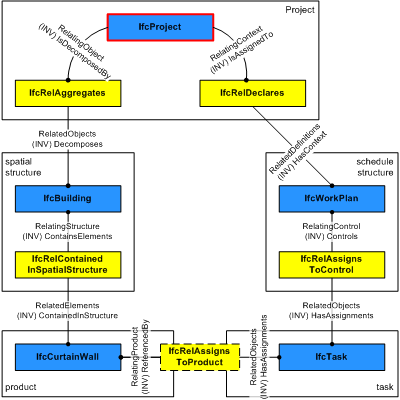Natural language names
 | Projekt |
 | Project |
 | Projet |
 | Projekt |
 | Project |
 | Projet |
| Item | SPF | XML | Change | Description | IFC2x3 to IFC4 |
|---|---|---|---|---|
| IfcProject | ||||
| OwnerHistory | MODIFIED | Instantiation changed to OPTIONAL. | ||
| RepresentationContexts | MODIFIED | Instantiation changed to OPTIONAL. | ||
| UnitsInContext | MODIFIED | Instantiation changed to OPTIONAL. |
IfcProject indicates the undertaking of some design, engineering, construction, or maintenance activities leading towards a product. The project establishes the context for information to be exchanged or shared, and it may represent a construction project but does not have to. The IfcProject's main purpose in an exchange structure is to provide the root instance and the context for all other information items included.
The context provided by the IfcProject includes:
HISTORY New entity in IFC1.0
IFC4 CHANGE The attributes RepresentationContexts and UnitsInContext are made optional and are promoted to supertype IfcContext.
Informal Propositions:
| Rule | Description |
|---|---|
| HasName | The Name attribute has to be provided for IfcProject. It is the short name for the project. |
| CorrectContext | If a RepresentationContexts relation is provided then there shall be no instance of IfcGeometricRepresentationSubContext directly included in the set of RepresentationContexts. |
| NoDecomposition | The IfcProject represents the root of the any decomposition tree. It shall therefore not be used to decompose any other object definition. |

| # | Attribute | Type | Cardinality | Description | C |
|---|---|---|---|---|---|
| IfcRoot | |||||
| 1 | GlobalId | IfcGloballyUniqueId | [1:1] | Assignment of a globally unique identifier within the entire software world. | X |
| 2 | OwnerHistory | IfcOwnerHistory | [0:1] |
Assignment of the information about the current ownership of that object, including owning actor, application, local identification and information captured about the recent changes of the object,
NOTE only the last modification in stored - either as addition, deletion or modification. | X |
| 3 | Name | IfcLabel | [0:1] | Optional name for use by the participating software systems or users. For some subtypes of IfcRoot the insertion of the Name attribute may be required. This would be enforced by a where rule. | X |
| 4 | Description | IfcText | [0:1] | Optional description, provided for exchanging informative comments. | X |
| IfcObjectDefinition | |||||
| HasAssignments | IfcRelAssigns @RelatedObjects | S[0:?] | Reference to the relationship objects, that assign (by an association relationship) other subtypes of IfcObject to this object instance. Examples are the association to products, processes, controls, resources or groups. | X | |
| Nests | IfcRelNests @RelatedObjects | S[0:1] | References to the decomposition relationship being a nesting. It determines that this object definition is a part within an ordered whole/part decomposition relationship. An object occurrence or type can only be part of a single decomposition (to allow hierarchical strutures only). | X | |
| IsNestedBy | IfcRelNests @RelatingObject | S[0:?] | References to the decomposition relationship being a nesting. It determines that this object definition is the whole within an ordered whole/part decomposition relationship. An object or object type can be nested by several other objects (occurrences or types). | X | |
| HasContext | IfcRelDeclares @RelatedDefinitions | S[0:1] | References to the context providing context information such as project unit or representation context. It should only be asserted for the uppermost non-spatial object. | X | |
| IsDecomposedBy | IfcRelAggregates @RelatingObject | S[0:?] | References to the decomposition relationship being an aggregation. It determines that this object definition is whole within an unordered whole/part decomposition relationship. An object definitions can be aggregated by several other objects (occurrences or parts). | X | |
| Decomposes | IfcRelAggregates @RelatedObjects | S[0:1] | References to the decomposition relationship being an aggregation. It determines that this object definition is a part within an unordered whole/part decomposition relationship. An object definitions can only be part of a single decomposition (to allow hierarchical strutures only). | X | |
| HasAssociations | IfcRelAssociates @RelatedObjects | S[0:?] | Reference to the relationship objects, that associates external references or other resource definitions to the object.. Examples are the association to library, documentation or classification. | X | |
| IfcContext | |||||
| 5 | ObjectType | IfcLabel | [0:1] |
The object type denotes a particular type that indicates the object further. The use has to be established at the level of instantiable subtypes.
NOTE Subtypes of IfcContext do not introduce a PredefinedType attribute, therefore the usage of ObjectType is not bound to the selection of USERDEFINED within the PredefinedType enumaration. | X |
| 6 | LongName | IfcLabel | [0:1] | Long name for the context as used for reference purposes. | X |
| 7 | Phase | IfcLabel | [0:1] | Current project phase, or life-cycle phase of this project. Applicable values have to be agreed upon by view definitions or implementer agreements. | X |
| 8 | RepresentationContexts | IfcRepresentationContext | S[1:?] | Context of the representations used within the context. When the context is a project and it includes shape representations for its components, one or several geometric representation contexts need to be included that define e.g. the world coordinate system, the coordinate space dimensions, and/or the precision factor. | X |
| 9 | UnitsInContext | IfcUnitAssignment | [0:1] | Units globally assigned to measure types used within the context. | X |
| IsDefinedBy | IfcRelDefinesByProperties @RelatedObjects | S[0:?] | Set of relationships to property set definitions attached to this context. Those statically or dynamically defined properties contain alphanumeric information content that further defines the context. | X | |
| Declares | IfcRelDeclares @RelatingContext | S[0:?] | Reference to the IfcRelDeclares relationship that assigns the uppermost entities of includes hierarchies to this context instance.
NOTE The spatial hiearchy is assigned to IfcProject using the IfcRelAggregates relationship. This is a single exception due to compatibility reasons with earlier releases. | X | |
| IfcProject | |||||
Spatial Decomposition
The Spatial Decomposition concept applies to this entity as shown in Table 4.
| ||||||||
Table 4 — IfcProject Spatial Decomposition |
The IfcProject is used to reference the root of the spatial structure of a building or other construction project (that serves as the primary project breakdown and is required to be hierarchical). The spatial structure elements are linked together, and to the IfcProject, by using the objectified relationship IfcRelAggregates.
The following constraints are applied to using the relationshio IfcRelAggregates in context of IfcProject
NOTE The anomaly to use the composition structure through IfcRelAggregates for assigning the uppermost spatial container to IfcProject is due to upward compatibility reasons with earlier releases of this standard.
Figure 119 illustrates project relationships with spatial structures, elements, and element type libraries.
 |
Figure 119 — Project spatial structure, products and product type library |
Project Declaration
The Project Declaration concept applies to this entity as shown in Table 5.
| ||||||||||||||||||
Table 5 — IfcProject Project Declaration |
The IfcProject is also the context for other information about the construction project such as a work plan. Non-product structures are assigned by their first level object to IfcProject using the IfcRelDeclares relationship. The IfcProject provides the context for work plans (or other non-product based) descriptions of the construction project. It is handled by the objectified relationship IfcRelDeclares.
NOTE The spatial structure and the schedule structure can be decomposed. For example the IfcBuilding can be decomposed into IfcBuildingStorey's, and the IfcWorkPlan can be decomposed into IfcWorkSchedule's.
NOTE The products and tasks can be decomposed further. For example the IfcCurtainWall can be decomposed into IfcMember and IfcPlate, the IfcTask can be decomposed into other IfcTask's.
NOTE The products and tasks can have direct linking relationships. For example the IfcCurtainWall can be assigned to a IfcTask as an input or output for a construction schedule.
Figure 120 illustrates the use of IfcProject as context for work plans or work schedules.
 | |
|
Figure 120 — Project spatial and work plan structure | |
Project Units
The Project Units concept applies to this entity as shown in Table 6.
| ||||
Table 6 — IfcProject Project Units |
Project Representation Context
The Project Representation Context concept applies to this entity as shown in Table 7.
| |||||||||
Table 7 — IfcProject Project Representation Context |
Project Classification Information
The Project Classification Information concept applies to this entity.
Project Document Information
The Project Document Information concept applies to this entity.
Project Library Information
The Project Library Information concept applies to this entity.
| # | Concept | Model View |
|---|---|---|
| IfcRoot | ||
| Software Identity | Common Use Definitions | |
| Revision Control | Common Use Definitions | |
| IfcProject | ||
| Spatial Decomposition | Common Use Definitions | |
| Project Declaration | Common Use Definitions | |
| Project Units | Common Use Definitions | |
| Project Representation Context | Common Use Definitions | |
| Project Classification Information | Common Use Definitions | |
| Project Document Information | Common Use Definitions | |
| Project Library Information | Common Use Definitions | |
<xs:element name="IfcProject" type="ifc:IfcProject" substitutionGroup="ifc:IfcContext" nillable="true"/>
<xs:complexType name="IfcProject">
<xs:complexContent>
<xs:extension base="ifc:IfcContext"/>
</xs:complexContent>
</xs:complexType>
ENTITY IfcProject
SUBTYPE OF (IfcContext);
WHERE
HasName : EXISTS(SELF\IfcRoot.Name);
CorrectContext : NOT(EXISTS(SELF\IfcContext.RepresentationContexts)) OR
(SIZEOF(QUERY(Temp <* SELF\IfcContext.RepresentationContexts |
'IFCREPRESENTATIONRESOURCE.IFCGEOMETRICREPRESENTATIONSUBCONTEXT' IN TYPEOF(Temp)
)) = 0);
NoDecomposition : SIZEOF(SELF\IfcObjectDefinition.Decomposes) = 0;
END_ENTITY;